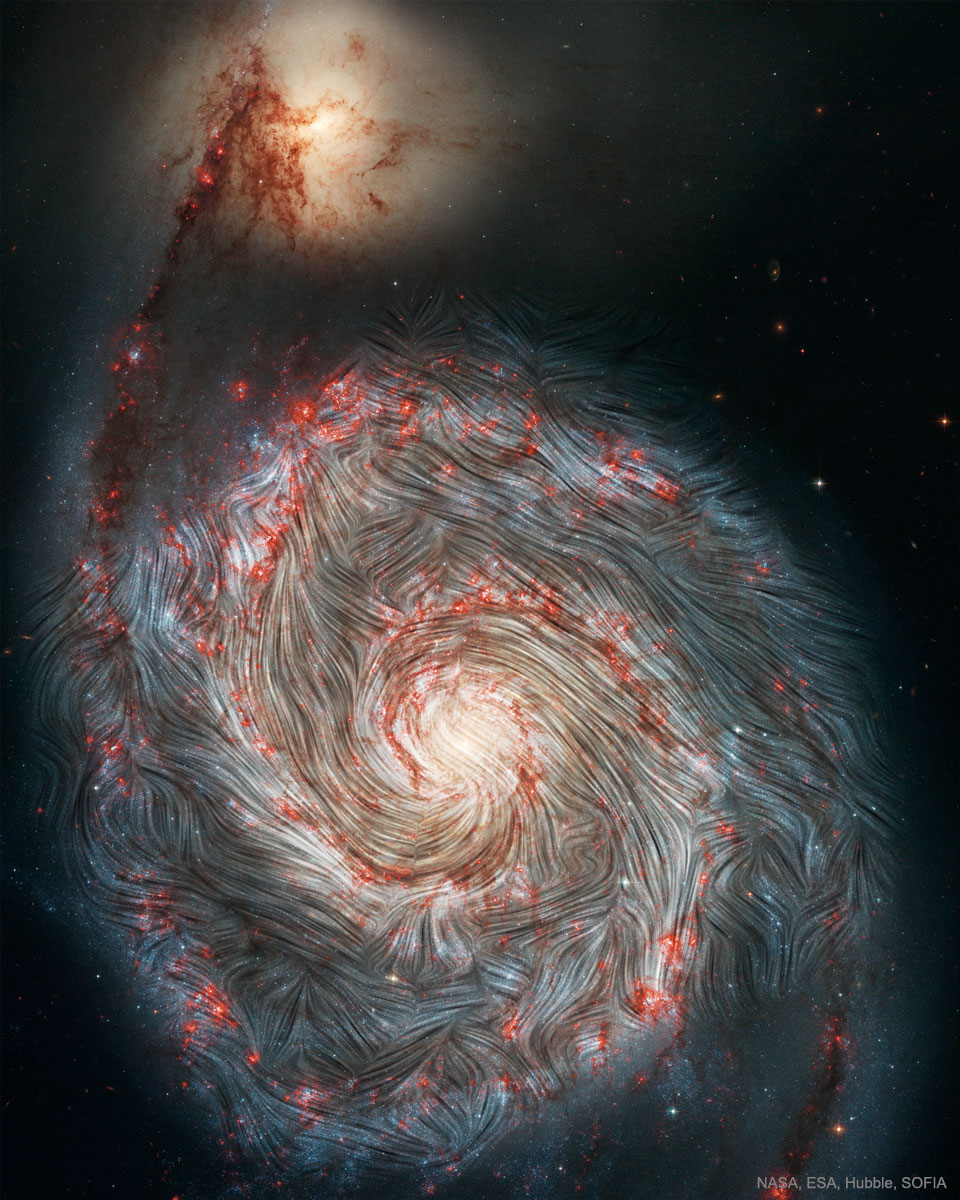20. January 2021
渦輪星系 ê 磁場

探索宇宙1!逐工會揀一幅無仝款 ê 影像抑是相片,𤆬你熟似咱這个迷人 ê 宇宙,閣有專業天文學者2為你3解說4。
- 原始文章:The Magnetic Field of the Whirlpool Galaxy
- 影像來源:NASA, SOFIA, HAWC+, Alejandro S. Borlaff; JPL-Caltech, ESA, Hubble
- 文稿:Jayanne English(U. Manitoba)
- 台文翻譯:An-Li Tsai (NCU)
[漢羅] 渦輪星系 ê 磁場
磁場敢一定會佮星系 ê 捲螺仔手骨仝一个方向?這个用正面向咱 ê 渦輪星系(M51),是佇盤仔形星系內底,一个看會著真清楚 ê 捲螺仔波形 ê 星系。咱用 電波望遠鏡 來 kā 看,會當看著磁場 綴著 捲螺仔 手骨 ê 曲度。毋閣,NASA 有一台佇天頂咧飛 ê 紅外線平流層望遠鏡(SOFIA),煞看著 M51 ê 磁場 佇星系盤 ê 外沿交織。磁場會當佇 紅外線波段,像 偏光鏡原理按呢,ùi 塗粉粒 ê 排列方向推算出來。疊佇 這張影像 面頂 ê 線,是用 演算法 kā 偏振光算出來 ê 磁場方向連起來 ê。影像頂懸反紅 ê 恆星形成區,是用 哈伯太空望遠鏡翕 ê。是講,可能是影像頂懸彼粒 星系 伴 ê 引力,kā 這粒塗粉滿滿是 ê 星系拖去,產生較強 ê 亂流,kā 塗粉絞絞去,才會佇星系 ê 外沿手骨,產生這款料想袂到 ê 磁場形態。
[POJ] O-lûn seng-hē ê chû-tiûⁿ
Chû-tiûⁿ kám it-tēng ē kah seng-hē ê kńg-lê-á chhiú-kut kâng chi̍t-ê hong-hiòng? Chi̍t-ê iōng chiàⁿ-bīn hiòng--lán-ê O-lûn seng-hē (M gō͘-cha̍p-it), sī tī pôaⁿ-á-hêng seng-hē lāi-té, chi̍t-ê khòaⁿ-ē-tio̍h chin chheng-chhó͘ ê kńg-lê-á pho-hêng ê seng-hē. Lâm iōng tiān-pho bōng-oán-kiàⁿ lâi kā khòaⁿ, ē-tàng khòaⁿ-tio̍h chû-tiûⁿ tòe-tio̍h kńg-lê-á chhiú-kut ê khiau-tō͘. M̄-koh, NASA ū chi̍t-tâi tē thiⁿ-téng leh poe ê Âng-gōa-sòaⁿ pêⁿ-liû-chân bōng-oán-kiàⁿ (SOFIA), soah khòaⁿ-tio̍h M gō͘-cha̍p-it ê chû-tiûⁿ tī seng-hē-pôaⁿ ê gōa-iân kau-chit. Chû-tiûⁿ ē-tàng tī âng-gōa-sòaⁿ pho-toān, chhiūⁿ phian-kng-kiàⁿ án-ne, ùi thô͘-hún-lia̍p ê phâi-lia̍t hong-hiòng thui-sǹg--chhut-lâi. Tha̍h tī chit-tiuⁿ iáⁿ-siōng bīn-téng ê sòaⁿ, sī iōng ián-soàn-hoat kā phian-chìn-kng sǹg--chhut-lâi-ê chû-tiûⁿ hong-hiòng liân--khí-lâi ê. Iáⁿ-siōng téng-koân hoán-âng ê hêng-chhiⁿ hêng-sêng-khu, sī iōng Ha-peh thài-khong bōng-oán-kiàⁿ hip-ê. Sī-kóng, khó-lêng sī iáⁿ-siōng téng-koân hit-lia̍p seng-hē ê ín-le̍k, kā chi̍t-lia̍p thô͘-hún móa-móa-sī ê seng-hē thoa--khì, sán-seng khah kiông ê loān-liû, kā thô͘-hún ká-ká-khì, chiah-ē tī seng-hē ê gōa-iân chhiūⁿ-kut, sán-seng chit-khòaⁿ liāu-sióng-bē-kàu ê chû-tiûⁿ hêng-thài.
[KIP] O-lûn sing-hē ê tsû-tiûnn
Tsû-tiûnn kám it-tīng ē kah sing-hē ê kńg-lê-á tshiú-kut kâng tsi̍t-ê hong-hiòng? Tsi̍t-ê iōng tsiànn-bīn hiòng--lán-ê O-lûn sing-hē (M gōo-tsa̍p-it), sī tī puânn-á-hîng sing-hē lāi-té, tsi̍t-ê khuànn-ē-tio̍h tsin tshing-tshóo ê kńg-lê-á pho-hîng ê sing-hē. Lâm iōng tiān-pho bōng-uán-kiànn lâi kā khuànn, ē-tàng khuànn-tio̍h tsû-tiûnn tuè-tio̍h kńg-lê-á tshiú-kut ê khiau-tōo. M̄-koh, NASA ū tsi̍t-tâi tē thinn-tíng leh pue ê Âng-guā-suànn pênn-lîu-tsân bōng-uán-kiànn (SOFIA), suah khuànn-tio̍h M gōo-tsa̍p-it ê tsû-tîunn tī sing-hē-puânn ê guā-iân kau-tsit. Tsû-tîunn ē-tàng tī âng-guā-suànn pho-tuān, tshiūnn phian-kng-kiànn án-ne, uì thôo-hún-lia̍p ê phâi-lia̍t hong-hiòng thui-sǹg--tshut-lâi. Tha̍h tī tsit-tiunn iánn-siōng bīn-tíng ê suànn, sī iōng ián-suàn-huat kā phian-tsìn-kng sǹg--tshut-lâi-ê tsû-tîunn hong-hiòng liân--khí-lâi ê. Iánn-siōng tíng-kuân huán-âng ê hîng-tshinn hîng-sîng-khu, sī iōng Ha-peh thài-khong bōng-uán-kiànn hip-ê. Sī-kóng, khó-lîng sī iánn-siōng tíng-kuân hit-lia̍p sing-hē ê ín-li̍k, kā tsi̍t-lia̍p thôo-hún muá-muá-sī ê sing-hē thua--khì, sán-sing khah kiông ê luān-lîu, kā thôo-hún ká-ká-khì, tsiah-ē tī sing-hē ê guā-iân tshiūnn-kut, sán-sing tsit-khuànn liāu-sióng-bē-kàu ê tsû-tîunn hîng-thài.
[English] The Magnetic Field of the Whirlpool Galaxy
Do magnetic fields always flow along spiral arms? Our face-on view of the Whirlpool Galaxy (M51) allows a spectacularly clear view of the spiral wave pattern in a disk-shaped galaxy. When observed with a radio telescope , the magnetic field appears to trace the arms' curvature . However, with NASA’s flying Stratospheric Observatory for Infrared Astronomy (SOFIA) observatory, the magnetic field at the outer edge of M51's disk appears to weave across the arms instead. Magnetic fields are inferred by grains of dust aligning in one direction and acting like polaroid glasses on infrared light . In the featured image , the field orientations determined from this polarized light are algorithmically connected , creating streamlines . Possibly the gravitational tug of the companion galaxy , at the top of the frame, on the dusty gas of the reddish star-forming regions, visible in the Hubble Space Telescope image , enhances turbulence -- stirring the dust and lines to produce the unexpected field pattern of the outer arms.
詞彙學習
| 漢羅 | POJ | KIP | 華語 | English |
|---|---|---|---|---|
| 渦輪星系 | O-lûn seng-hē | O-lûn sing-hē | 渦狀星系 | Whirlpool Galaxy |
| 磁場 | chû-tiûⁿ | tsû-tiûnn | 磁場 | magnetic field |
| 捲螺仔手骨 | kńg-lê-á chhiú-kut | kńg-lê-á tshiú-kut | 旋臂 | spiral arm |
| 盤仔形星系 | pôaⁿ-á-hêng seng-hē | puânn-á-hîng sing-hē | 盤狀星系 | disk-shape galaxy |
| 捲螺仔波形 | kńg-lê-á pho-hêng | kńg-lê-á pho-hîng | 螺旋波形 | spiral wave pattern |
| 電波望遠鏡 | tiān-pho bōng-oán-kiàⁿ | tiān-pho bōng-uán-kiànn | 電波望遠鏡 | radio telescope |
| 曲度 | khiau-tō͘ | khiau-tōo | 曲率 | curvature |
| 紅外線平流層望遠鏡 | Âng-gōa-sòaⁿ pêⁿ-liû-chân bōng-oán-kiàⁿ | Âng-guā-suànn pênn-liû-tsân bōng-uán-kiànn | 紅外線平流層望遠鏡 | Stratospheric Observatory for Infrared Astronomy (SOFIA) |
| 星系盤 | seng-hē-pôaⁿ | sing-hē-puânn | 星系盤 | galactic disk |
| 偏光鏡 | phian-kng-kiàⁿ | phian-kng-kiànn | 偏光鏡 | polaroid glasses |
| 塗粉粒 | thô͘-hún-lia̍p | thôo-hún-lia̍p | 灰塵粒 | grains of dust |
| 演算法 | ián-soàn-hoat | ián-suàn-huat | 演算法 | algorithm |
| 偏振光 | phian-chìn-kng | phian-tsìn-kng | 偏振光 | polarized light |
| 恆星形成區 | hêng-chhiⁿ hêng-sêng-khu | hîng-tshinn hîng-sîng-khu | 恆星形成區 | star-forming region |
| 哈伯太空望遠鏡 | Ha-peh thài-khong bōng-oán-kiàⁿ | Ha-peh thài-khong bōng-uán-kiànn | 哈伯太空望遠鏡 | Hubble Space Telescope |
| 星系伴 | seng-hē-pôaⁿ | puânn | 伴星系 | companion galaxy |
| 引力 | ín-le̍k | ín-li̍k | 引力 | gravity |
| 亂流 | loān-liû | luān-liû | 亂流 | turbulence |